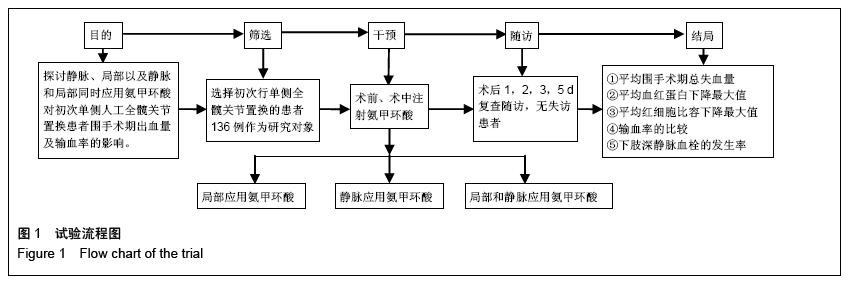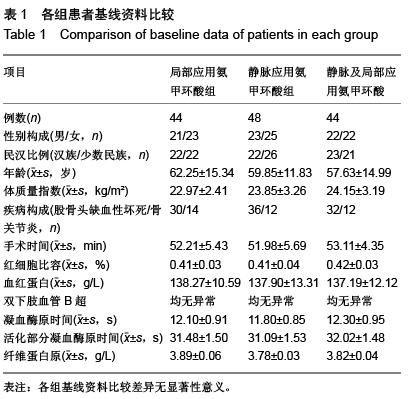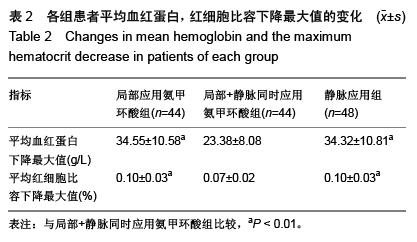| [1] Lemos MJ, Healy WL. Blood transfusion in orthopaedic operations. J Bone Joint Surg Am. 1996;78(8):1260-1270.
[2] Triulzi DJ, Vanek K, Ryan DH, et al. A clinical and immunologic study of blood transfusion and postoperative bacterial infection in spinal surgery. Transfusion. 1992; 32(6):517-524.
[3] Vamvakas EC, Blajchman MA. Transfusion-related mortality: the ongoing risks of allogeneic blood transfusion and the available strategies for their prevention. Blood 2009;113(15):3406-3417.
[4] Paul JE, Ling E, Lalonde C, et al. Deliberate hypotension in orthopedic surgery reduces blood loss and transfusion requirements: a meta-analysis of randomized controlled trials. Can J Anaesth. 2007;54(10):799-810.
[5] Niemi TT, Pitkanen M, Syrjala M, et al. Comparison of hypotensive epidural anaesthesia and spinal anaesthesia on blood loss and coagulation during and after total hip arthroplasty. Acta Anaesthesiol Scand. 2000;44(4):457-464.
[6] Hawi N, Kendoff DO, Hessling U, et al. Effectiveness of an autologous transfusion system following cemented and non-cemented revisions of total hip arthroplasty. Int Orthop. 2014;38(8):1603-1608.
[7] Horstmann WG, Swierstra MJ, Ohanis D, et al. Favourable results of a new intraoperative and postoperative filtered autologous blood re-transfusion system in total hip arthroplasty: a randomised controlled trial. Int Orthop. 2014;38(1):13-18.
[8] Rajesparan K, Biant LC, Ahmad M, et al. The effect of an intravenous bolus of tranexamic acid on blood loss in total hip replacement. J Bone Joint Surg (Br). 2009;91(6): 776-783.
[9] Kazemi SM, Mosaffa F, Eajazi A, et al. The effect of tranexamic acid on reducing blood loss in cementless total hip arthroplasty under epidural anesthesia. Orthopedics. 2010;33(1):17.
[10] Singh J, Ballal MS, Mitchell P, et al. Effects of tranexamic acid on blood loss during total hip arthroplasty. J Orthop Surg (Hong Kong). 2010;18(3):282-286.
[11] Claeys MA, Vermeersch N, Haentjens P. Reduction of blood loss with tranexamic acid in primary total hip replacement surgery. Acta Chir Belg. 2007;107(4):397.
[12] Sukeik M, Alshryda S, Haddad FS, et al. Systematic review and meta-analysis of the use of tranexamic acid in total hip replacement. J Bone Joint Surg Br. 2011;93(1):39-46.
[13] Imai N, Dohmae Y, Suda K, et al. Tranexamic acid for reduction of blood loss during total hip arthroplasty. J Arthroplasty. 2012;27(10):1838-1843.
[14] Johansson T, Pettersson LG, Lisander B. Tranexamic acid in total hip arthroplasty saves blood and money: a randomized, double-blind study in 100 patients. Acta Orthop. 2005;76(3):314-319.
[15] Noordin S, Waters TS, Garbuz DS, et al. Tranexamic acid reduces allogenic transfusion in revision hip arthroplasty. Clin Orthop Relat Res. 2011;469(2):541-546.
[16] Alshryda S, Mason J, Sarda P, et al. Topical (intra-articular) tranexamic acid reduces blood loss and transfusion rates following total hip replacement: a randomized controlled trial (TRANX-H). J Bone Joint Surg Am. 2013;95(21): 1969-1974.
[17] Konig G, Hamlin BR, Waters JH. Topical tranexamic acid reduces blood loss and transfusion rates in total hip and total knee arthroplasty. J Arthroplasty. 2013;28(9):1473.
[18] Yue C, Kang P, Pei F et al. Topical application of tranexamic acid in primary total hiparthroplasty: a randomized double-blind controlled trial. J Arthroplasty. 2014;29(12):2452-2456.
[19] Sattar S, Mason J, Sarda P, et al. Topical (intra-articular) tranexamic acid reduces blood loss and transfusion rates following total hip replacement: a randomized controlled trial (TRANX-H). J Bone Joint Surg Am. 2013;95(21): 1969-1974.
[20] Martin JG, Cassatt KB, Kincaid-Cinnamon KA, et al. Topical administration of tranexamic Acid in primary total hip and total knee arthroplasty. J Arthroplasty. 2014;29(5):889-894.
[21] 邱贵兴.中国骨科大手术静脉血栓栓塞症预防指南[J].中华关节外科杂志:电子版,2009,3(3):380-383.
[22] 岳辰,谢锦伟,裴福兴,等.静脉联合局部应用氨甲环酸减少初次全髋关节置换围置换期失血的有效性及安全性研究[J].中华骨与关节外科杂志,2015,8(1):44-48.
[23] Nadler SB, Hidalgo JH, Bloch T. Prediction of blood volume in normal human adults. Surgery. 1962;51(2):224-232.
[24] Liu X, Zhang X, Chen Y, et al. Hidden blood loss after total hip arthroplasty. Jarthroplasty. 2011;26(7):1100-1105.
[25] Price AJ. Hemostatic changes and postoperative deep-vein thrombosis associated with use of a pneumatic tourniquet. J Bone Joint Surg Am. 1982;64(8):1260.
[26] Kazemi SM, Mosaffa F, Eajazi A, et al. The effect of tranexamic acid on reducing blood loss in cementless total hip arthroplasty under epidural anesthesia. Orthopedics. 2010;33(1):17.
[27] Prentice CR. Basis of antifibrinolytic therapy. J Clin Pathol Suppl (R Coll Pathol). 1980;14:35.
[28] Mannucci PM. Hemostatic drugs. N Engl J Med. 1998; 339(4): 245-253.
[29] Wind TC, Barfield WR, Moskal JT. The effect of tranexamic acid on transfusion rate in primary total hip arthroplasty. J Arthroplasty. 2014;29(2):387-389.
[30] Wei W, Wei BF. Comparison of topical and intravenous tranexamic acid on blood loss and transfusion rates in total hip arthroplasty. J Arthrop. 2014;29(11):2113-2116. |
.jpg)


